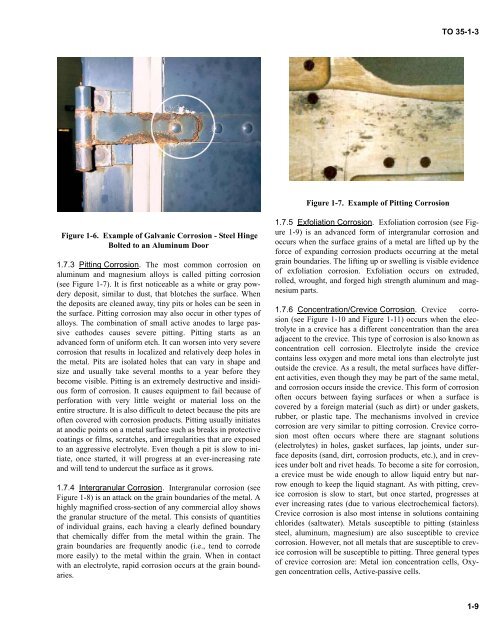TO 35-1-3 - Robins Air Force Base
TO 35-1-3 - Robins Air Force Base
TO 35-1-3 - Robins Air Force Base
Create successful ePaper yourself
Turn your PDF publications into a flip-book with our unique Google optimized e-Paper software.
<strong>TO</strong> <strong>35</strong>-1-3<br />
Figure 1-7. Example of Pitting Corrosion<br />
Figure 1-6. Example of Galvanic Corrosion - Steel Hinge<br />
Bolted to an Aluminum Door<br />
1.7.3 Pitting Corrosion. The most common corrosion on<br />
aluminum and magnesium alloys is called pitting corrosion<br />
(see Figure 1-7). It is first noticeable as a white or gray powdery<br />
deposit, similar to dust, that blotches the surface. When<br />
the deposits are cleaned away, tiny pits or holes can be seen in<br />
the surface. Pitting corrosion may also occur in other types of<br />
alloys. The combination of small active anodes to large passive<br />
cathodes causes severe pitting. Pitting starts as an<br />
advanced form of uniform etch. It can worsen into very severe<br />
corrosion that results in localized and relatively deep holes in<br />
the metal. Pits are isolated holes that can vary in shape and<br />
size and usually take several months to a year before they<br />
become visible. Pitting is an extremely destructive and insidious<br />
form of corrosion. It causes equipment to fail because of<br />
perforation with very little weight or material loss on the<br />
entire structure. It is also difficult to detect because the pits are<br />
often covered with corrosion products. Pitting usually initiates<br />
at anodic points on a metal surface such as breaks in protective<br />
coatings or films, scratches, and irregularities that are exposed<br />
to an aggressive electrolyte. Even though a pit is slow to initiate,<br />
once started, it will progress at an ever-increasing rate<br />
and will tend to undercut the surface as it grows.<br />
1.7.4 Intergranular Corrosion. Intergranular corrosion (see<br />
Figure 1-8) is an attack on the grain boundaries of the metal. A<br />
highly magnified cross-section of any commercial alloy shows<br />
the granular structure of the metal. This consists of quantities<br />
of individual grains, each having a clearly defined boundary<br />
that chemically differ from the metal within the grain. The<br />
grain boundaries are frequently anodic (i.e., tend to corrode<br />
more easily) to the metal within the grain. When in contact<br />
with an electrolyte, rapid corrosion occurs at the grain boundaries.<br />
1.7.5 Exfoliation Corrosion. Exfoliation corrosion (see Figure<br />
1-9) is an advanced form of intergranular corrosion and<br />
occurs when the surface grains of a metal are lifted up by the<br />
force of expanding corrosion products occurring at the metal<br />
grain boundaries. The lifting up or swelling is visible evidence<br />
of exfoliation corrosion. Exfoliation occurs on extruded,<br />
rolled, wrought, and forged high strength aluminum and magnesium<br />
parts.<br />
1.7.6 Concentration/Crevice Corrosion. Crevice corrosion<br />
(see Figure 1-10 and Figure 1-11) occurs when the electrolyte<br />
in a crevice has a different concentration than the area<br />
adjacent to the crevice. This type of corrosion is also known as<br />
concentration cell corrosion. Electrolyte inside the crevice<br />
contains less oxygen and more metal ions than electrolyte just<br />
outside the crevice. As a result, the metal surfaces have different<br />
activities, even though they may be part of the same metal,<br />
and corrosion occurs inside the crevice. This form of corrosion<br />
often occurs between faying surfaces or when a surface is<br />
covered by a foreign material (such as dirt) or under gaskets,<br />
rubber, or plastic tape. The mechanisms involved in crevice<br />
corrosion are very similar to pitting corrosion. Crevice corrosion<br />
most often occurs where there are stagnant solutions<br />
(electrolytes) in holes, gasket surfaces, lap joints, under surface<br />
deposits (sand, dirt, corrosion products, etc.), and in crevices<br />
under bolt and rivet heads. To become a site for corrosion,<br />
a crevice must be wide enough to allow liquid entry but narrow<br />
enough to keep the liquid stagnant. As with pitting, crevice<br />
corrosion is slow to start, but once started, progresses at<br />
ever increasing rates (due to various electrochemical factors).<br />
Crevice corrosion is also most intense in solutions containing<br />
chlorides (saltwater). Metals susceptible to pitting (stainless<br />
steel, aluminum, magnesium) are also susceptible to crevice<br />
corrosion. However, not all metals that are susceptible to crevice<br />
corrosion will be susceptible to pitting. Three general types<br />
of crevice corrosion are: Metal ion concentration cells, Oxygen<br />
concentration cells, Active-passive cells.<br />
1-9
















